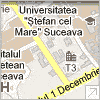Pattern Recognition and Image Processing Research Laboratory
The Pattern Recognition and Image Processing Laboratory is a component of the Research Center in Computer Science (certified by CNCSIS) at the “Ştefan cel Mare” University of Suceava with research activities being conducted on general pattern recognition and image processing techniques, gesture recognition and human-computer interaction, distributed intelligence and vision-guided robotics.
Gesture-based interaction: head and hand gesture detection and recognition



OBJECTIVES
The Pattern Recognition and Image Processing Lab aims to perform high quality research in pattern recognition, image processing, machine vision, distributed intelligence, and vision-guided robotics. We investigate the use of computers in order to recognize a wide range of objects, to identify high discriminatory features and to design supervised and unsupervised learning algorithms. A number of applications deal with image processing, scene analyzing, robot navigation, automatic surveillance and tracking, face modeling, gesture-based human-computer interaction.
MAIN RESEARCH EQUIPMENT
Desktop computers, high quality video cameras, data gloves, cluster of about 1 Tflops.
MAIN RESEARCH THEMES
Gesture recognition
Natural gestures as a means of human computer interaction have the great advantage of being the ideal interface as a natural, efficient and intuitive means of communication. Posture and motion recognition applications were developed in order to consider gestures as interface for human-computer interaction. An interesting application made by the PhD student Ciprian Ovidiu UNGUREANU, aims to control the mouse pointer by head gesture recognition. The challenge is to recognize the head movements from a video camera installed in the front of an operator in order to control the mouse pointer on the screen in the case of Windows based systems. It is proposed an integrated approach to real-time detection, tracking and gesture recognition of human head, which is intended to be used for controlling the mouse cursor of a desktop system as hands free or no-touch interaction. Research is also being conducted on developing and controlling mobile robots via gesture-based interfaces.
Gesture recognition research was conducted in the frame of 131-CEEX project, INTEROB.
TEAM
Professor Ştefan Gheorghe PENTIUC, PhD Eng.
Phone: 40.741 221 403, 0230/ 216 147 int. 236, E-mail: pentiuc@eed.usv.ro
Professor Adrian GRAUR, PhD Eng.
Asociated Professor Cristina TURCU, PhD Eng.
Lecturer Remus PRODAN, PhD Eng.
Lecturer Tudor CERLINCĂ, PhD Eng
Lecturer Radu-Daniel VATAVU, PhD Eng
Lecturer Mirela DANUBIANU, PhD Eng.
Lecturer Ovidiu SCHIPOR, PhD Eng.
Lecturer Adina BĂRÎLĂ, inf.
Assistant Felicia Belciug GÎZĂ, eng.
Interactive surfaces
Research is being conducted on interactive surfaces and enhancing current tabletop settings with computer vision and sensor-based systems. We are currently considering applications in the domain of enhanced human-computer interaction and computer games industry. A new interaction metaphor was introduced in the form of context-based interaction.



Interactive surfaces and context-based interaction
 |
 Logopaedic 3D model |
Automatic recognition of dyslalia affecting pre-scholars
Dyslalia is a speech disorder that affects pronunciation of one ore many sounds. The researches convert through a full system that targets interdisciplinary research having as main objective the development of methods, models, algorithms, with regards to the elaboration of a complete system addressing the therapy of dyslalia affecting pre-scholars, in a personalized and user centered manner. There is a powerful preoccupation at the European level in helping the people with speech disorders; that is why the EU Quality of Life and Management of Living Resources program has been developed. We developed an integrated system (56-CEEX, TERAPERS project) actually tested by Interschool Regional Logopaedic Center of Suceava.
Specific skills: pattern recognition, image processing, computer vision, distributed systems, human-computer interaction.
Collaborations: Laboratoire d'Informatique Fondamentale de Lille (U.S.T. Lille), Politecnico di Torino, KAHO Sint Lieven, Institute for Work and Technology Gelsenckirchen, Faculty of Automation and Computers Iasi, Faculty of Informatics Iasi, Politehnica University of Bucharest National Center for Information Technologies (Polytechnic University Bucharest).
